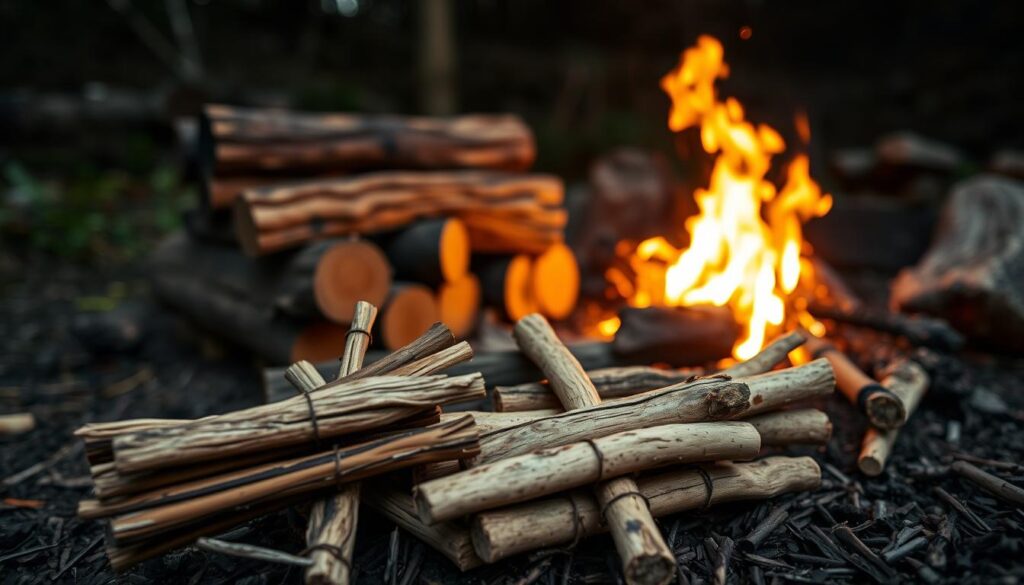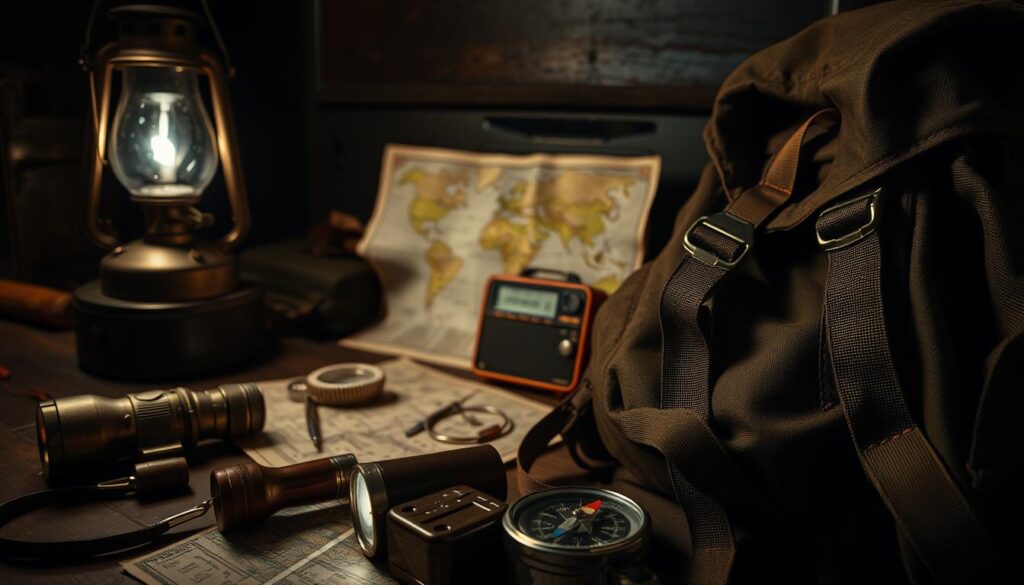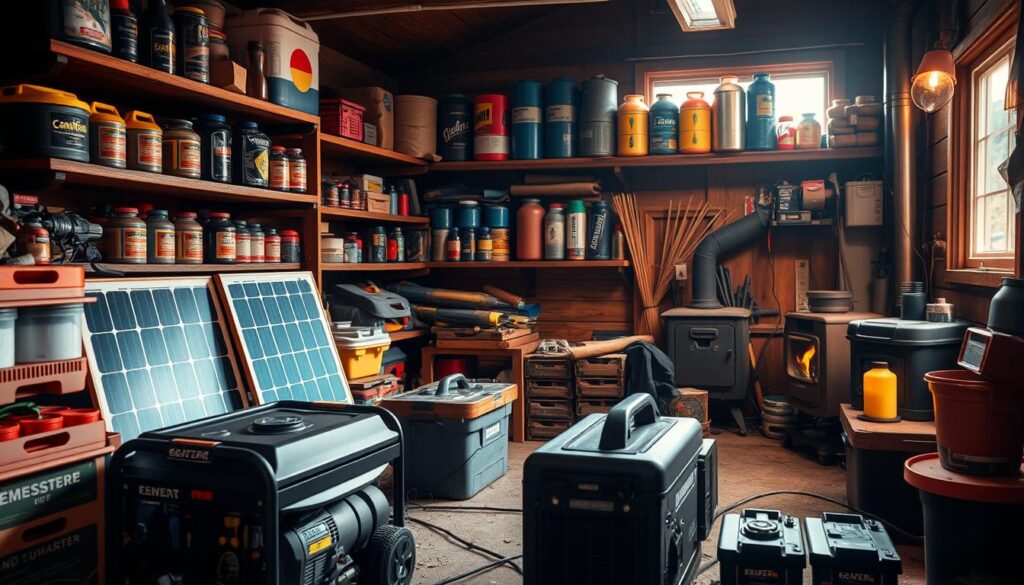Making a DIY fire starter is a rewarding camping experience. It’s easy to make and the materials are cheap. I’ve found that using flammable household items lets you get creative.
In this guide, I’ll show you how simple and versatile making your own fire starter can be. You’ll learn to use different materials to start a fire efficiently.
Key Takeaways
- DIY fire starters are easy to make and require inexpensive materials.
- Using household flammable items allows for creativity.
- This guide will walk you through the process of making your own fire starter.
Introduction to Outdoor Fire Starters
When you go into the wilderness, a good fire starter is key for warmth, cooking, and safety. Being able to start a fire fast can save your life in a survival situation.
Outdoor fire starters are a must-have for many outdoor lovers. They are reliable and efficient. Whether camping, hiking, or in a survival situation, a reliable fire starter is a game-changer.
What is an Outdoor Fire Starter?
An outdoor fire starter is a tool or device made to light a fire in different conditions. It can be simple, like a match, or complex, like a ferrocerium rod. The best outdoor fire starters work well in many environments.
Why Use an Outdoor Fire Starter?
The forest has many natural tinder sources. But, wet conditions or an unfamiliar place can make them hard to find. That’s when a personal fire starter is essential, ensuring you can start a fire when needed.
Using a waterproof and reliable outdoor fire starter is vital in emergencies. It lets you start a fire even when natural tinder is hard to find or wet.
Also, carrying a personal fire starter makes outdoor activities better. It gives you a quick way to start a fire for cooking or warmth. This adds to the fun and safety of your outdoor adventure.
Essential Materials for Fire Starters
Choosing the right materials is key for a fire starter. You want it to be effective, compact, and able to withstand the weather.
Natural Materials
Natural materials are easy to find and work well for fire starters. Dry leaves, twigs, and other flammable items from nature are good choices. You can also use newspaper and twine for a simple starter. Adding wax can make your fire starter burn longer.
Man-Made Options
Man-made materials can also make great fire starters. Petroleum jelly cotton balls are a favorite among outdoor lovers. Just dip cotton balls in petroleum jelly and keep them in a waterproof bag. Another option is wax matches, made to handle different weather. For more DIY fire starter ideas, see this article on DIY fire starters.
| Material | Description | Advantages |
|---|---|---|
| Newspaper | Dry newspaper sheets | Readily available, easy to use |
| Twine | String or twine | Can be used to bind materials |
| Wax | Beeswax or paraffin wax | Enhances burning time |
| Petroleum Jelly Cotton Balls | Cotton balls dipped in petroleum jelly | Effective in various weather conditions |
| Wax Matches | Matches coated with wax | Weather-resistant, reliable |
How to Make a Simple Fire Starter
Making a simple fire starter is a handy skill for outdoor activities. It’s useful for camping, hiking, or survival situations. Having a good outdoor fire starter can be a game-changer.
You can make a fire starter using common items. Two easy ways are using cotton balls with petroleum jelly or making wax matches. Both methods are easy and need little equipment.
Step-by-Step Instructions
For cotton balls, start by getting them and petroleum jelly. Soak the cotton balls in petroleum jelly until they’re fully covered. This makes them dry and easy to light. Store them in a waterproof container to keep them dry.
To make wax matches, you need kitchen matches and wax. Melt the wax in a double boiler or a heat-proof bowl over boiling water. Dip the matches in the wax, covering them well. Let them cool and harden before storing them in a dry spot.
Tips for Success
To make your camping fire starter or survival fire starter work well, remember these tips:
- Keep your fire starters in a dry, easy-to-reach spot.
- Practice using your fire starters before an emergency.
- Use different fire starting methods to have backups.
By following these steps and tips, you can make a dependable outdoor fire starter. It will help you on your outdoor adventures.
Using Household Items as Fire Starters
Going outdoors means you need a reliable fire starter. Luckily, many household items can be used for this. It’s a creative way to be ready for adventures while reducing waste.
Common Kitchen Ingredients
Many kitchen items can start fires. Dryer lint is very flammable and works well alone or mixed with other stuff. Candle wax is also great; melt it and mix with lint or cloth for a fire starter.
| Material | Preparation | Effectiveness |
|---|---|---|
| Dryer Lint | Collect and compress | Highly flammable |
| Candle Wax | Melt and mix with lint or cloth | Waterproof and compact |
| Cotton Cloth | Tear into strips and mix with wax or lint | Easy to ignite |
Repurposing Old Items
Old items like cotton t-shirts, newspapers, or cardboard can start fires. Shred or tear them into small pieces and mix with dryer lint or wax. This makes a good emergency fire starter.
Old cotton cloth can be torn into strips, dipped in wax, and used as a waterproof fire starter.
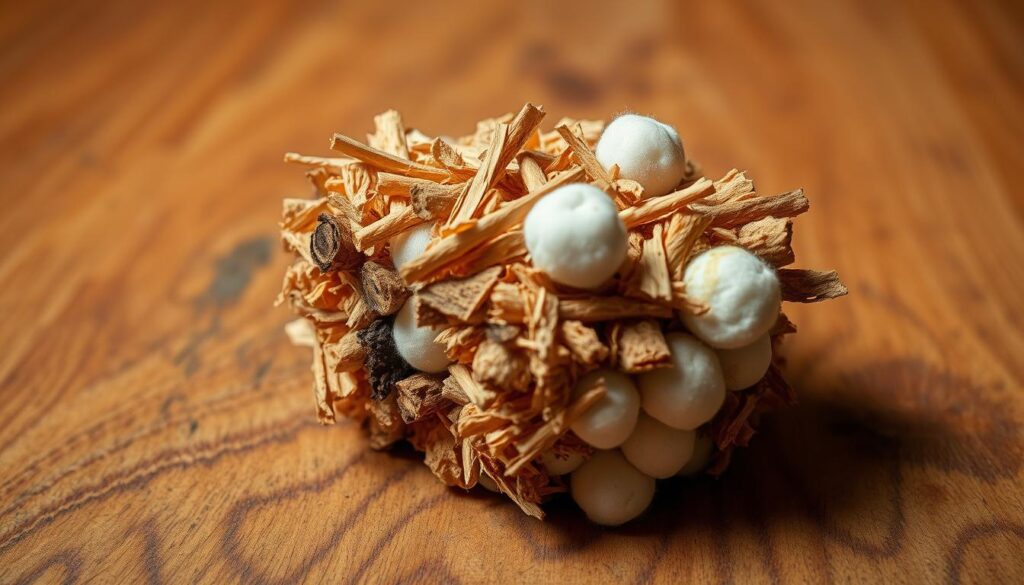
Using these items, you can make a compact fire starter that’s easy to carry. It’s effective and promotes sustainability for outdoor lovers.
Choosing the Right Location for Your Fire
Finding the perfect spot for your outdoor fire is key for a safe and fun time. I look at a few important things to make sure my fire is safe and easy to get to.
Safety Considerations
Safety is my number one concern. I pick a spot that’s far from things that can catch fire, like dry leaves and branches. A reliable fire starter helps me start the fire fast, which keeps me safe.
I also think about the wind direction to avoid fire dangers. Plus, I make sure the spot is flat, not windy, and won’t flood. This keeps the fire under control.
Accessibility and Convenience
But safety isn’t the only thing I think about. I also want the spot to be easy to get to, for when I need to check on the fire. A weather-resistant fire starter is great because it works well in different weather.
I also consider how close it is to where I’m camping or having a picnic. Having an outdoor fire starter that’s simple to use is important too.
By thinking about safety and convenience, I can have a warm and cozy fire. It makes my outdoor time even better.
Techniques for Igniting a Fire
When you go into the wilderness, knowing how to start a fire is key. Fire keeps you warm, lights your way, and lets you cook food. It’s a must-have for any outdoor trip.
Using Modern Tools
Starting a fire is now easier thanks to modern tools. A lighter or fire starter is a common choice. They give you a flame fast and easy.
The ferrocerium rod, or ferro rod, is another great tool. It makes sparks when scraped with a knife. These sparks can light tinder.
If you like tech, there are camping fire starters like electric and solar ones. They work well in wet or windy weather.
| Modern Tool | Description | Effectiveness |
|---|---|---|
| Lighter | Convenient and easy to use | High |
| Ferro Rod | Generates sparks to ignite tinder | High |
| Electric Fire Starter | Uses electricity to generate a flame | High |
Traditional Methods
Modern tools are handy, but knowing traditional fire starting is also important. Flint and steel is a classic method. It needs practice but works well.
Friction fire starting is another traditional way. It uses friction to make heat. It’s harder but rewarding.
“The ability to start a fire is one of the most fundamental skills for wilderness survival.” –
For those interested in traditional fire starting, many guides are out there. They teach you ancient techniques.
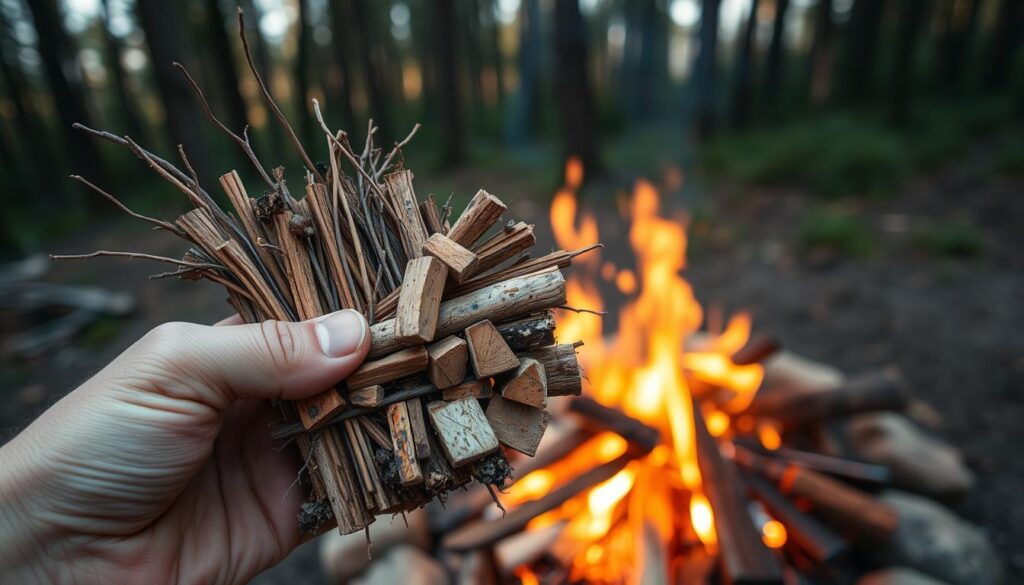
In summary, knowing how to start a fire is vital for outdoor lovers. Whether you like modern tools or traditional methods, fire is key for a great outdoor adventure.
The Role of Kindling in Fire Starting
In outdoor fire starting, kindling is key to a successful fire. It’s made of small, easy-to-light sticks and twigs. The right kindling can make starting a fire easy or hard.
What is Kindling?
Kindling includes small sticks, twigs, and other materials that light up quickly. Dryer lint, small dry sticks, and shredded bark are great examples. They burn fast and help build a fire slowly.
Best Kindling Options
Choosing the best kindling is important. Natural materials like dry leaves, grass, and small twigs work well. Man-made materials like dryer lint, shredded wax, or commercial fire starters also work. The most important thing is to pick dry, easy-to-burn materials.
| Kindling Material | Characteristics |
|---|---|
| Dry Leaves | Highly combustible, readily available |
| Dryer Lint | Dry, fluffy, and highly ignitable |
| Small Twigs | Dry, thin, and easily combustible |
| Shredded Bark | Dry, highly combustible |
Using a mix of these kindling materials makes a reliable fire starter. Remember, kindling must be dry. Dry kindling helps start a fire easily. This makes a compact fire starter that’s both efficient and reliable.
Also, a well-prepared kindling arrangement makes a lightweight fire starter. This is great for outdoor adventures because it’s easy to carry.
Maintaining the Fire Starter
I always make sure to maintain my outdoor fire starter. This way, it works when I need it most. Keeping your outdoor fire starter in good shape involves a few important steps.
First, a well-maintained fire starter is about safety and convenience, not just having a fire. It’s key to store your fire starters in a dry place, away from the elements.
Proper Storage
For dry fire starters, use waterproof containers. This is very important for waterproof fire starters and weather-resistant fire starters. It keeps them in top condition.
| Storage Method | Benefits |
|---|---|
| Waterproof Containers | Keeps fire starters dry in wet conditions |
| Air-Tight Bags | Protects from moisture and humidity |
| Cool, Dry Places | Prevents degradation from heat or moisture |
Replenishing Supplies
Check your fire starter supplies regularly and restock as needed. Make sure your kindling and tinder are in good shape. Also, have enough outdoor fire starters on hand.
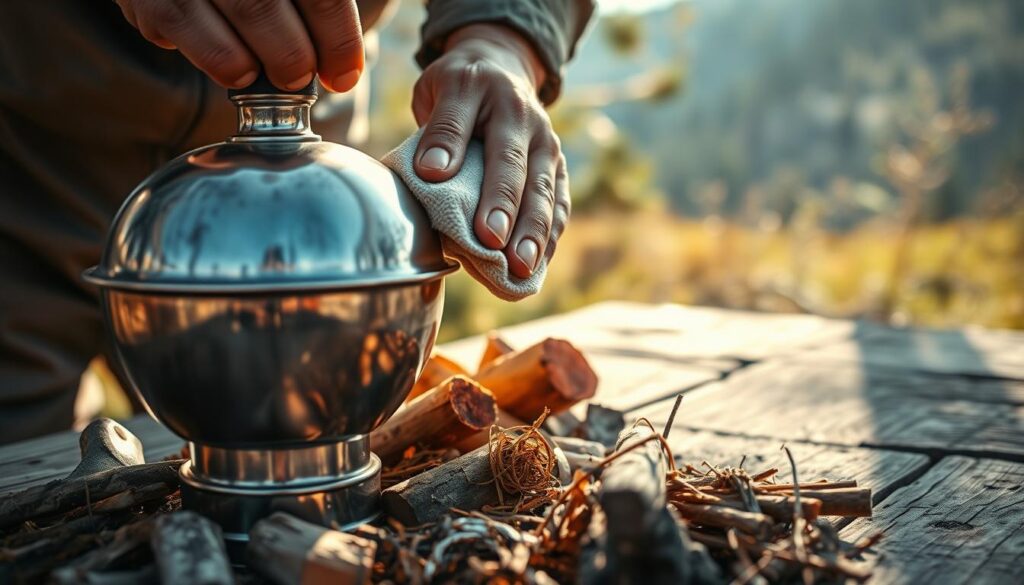
By following these simple tips, your outdoor fire starter will always be ready for your next adventure.
Troubleshooting Fire Starting Issues
Starting a fire in the wilderness can be tricky. A reliable fire starter is key, but even the best tools can face problems.
Common fire starting issues include damp conditions, not enough kindling, and poor fire starter quality. Knowing these problems helps solve them.
Common Problems and Solutions
Damp conditions are a big problem. I keep my survival fire starter dry and have a backup, like a lighter or waterproof matches.
- Using dry kindling and tinder helps with damp conditions.
- Scraping away damp soil to create a fire bed is also effective.
Not having enough kindling is another issue. I always carry dry, fluffy kindling.
| Problem | Solution |
|---|---|
| Damp Conditions | Use waterproof storage, dry kindling, and create a fire bed |
| Insufficient Kindling | Carry a supply of dry, fluffy kindling material |
| Poor Fire Starter Quality | Invest in a high-quality, reliable fire starter |
When to Seek Help
If I can’t start a fire after trying, I might need help. This could mean finding a nearby shelter or camp where others can assist.
Knowing when to ask for help is important, too. In emergency situations, starting a fire might not be the first thing to do. Seeking help becomes the main priority.
Outdoor Fire Safety Tips
When you go outside, a well-planned fire can be a big help. But, it’s key to keep fire safety in mind to avoid accidents and protect the environment.
Preparing for the Unexpected
Before starting a fire, I always check the weather and fire rules. Being ready for sudden weather changes or fire bans helps prevent accidents. It’s also important to have a plan, like knowing where water is and how to put out the fire.
A weather-resistant fire starter is great for bad weather. I always carry one to start a fire, even when it’s damp or windy.
Responsible Fire Practices
To manage fires responsibly, I make sure to fully put out the fire when I’m done. This means using water, stirring the ashes, and checking that the fire is gone. I also follow local fire bans and rules to avoid forest fires or other accidents.
| Fire Safety Tip | Description |
|---|---|
| Monitor Weather Conditions | Check local weather forecasts and fire restrictions before starting a fire. |
| Have a Plan | Know the nearest water source and have a means to extinguish the fire. |
| Fully Extinguish the Fire | Dousing the fire with water, stirring the ashes, and ensuring the fire is completely out. |
Enjoying Your Fire: Cooking and Warmth
Cooking over an open flame is a joy. A reliable fire starter makes it easy. You can quickly start a fire, making outdoor cooking fun.
Cooking Over an Open Flame
Cooking outdoors is fun and rewarding. A reliable fire starter helps you start a fire fast. This lets you enjoy cooking your meals.
Some benefits include:
- The ability to cook a variety of meals, from simple to complex dishes.
- The joy of enjoying a meal in the great outdoors.
- The flexibility to cook in different environments, whether camping or in your backyard.
Staying Warm During Cooler Nights
A lightweight fire starter keeps you warm at night. A fire provides warmth and comfort. It also makes you feel secure.
Some key aspects include:
- Maintaining a fire throughout the night for warmth.
- Using the fire to dry clothes or gear if needed.
- Creating a cozy ambiance that enhances the outdoor experience.
With a compact fire starter, your outdoor adventures are enjoyable and safe. It’s great for camping, hiking, or backyard fun. A reliable fire starter is a valuable companion.
Conclusion: Your Outdoor Fire Starting Adventure
Now you know how to make your own outdoor fire starters. Having a good fire starter is key for camping, survival, and enjoying the outdoors. This guide has shown you the importance of being ready with the right stuff and techniques.
Recap of Key Points
We talked about the best materials for fire starters, both natural and man-made. We also covered how to make a simple fire starter and pick the right spot for your fire. Plus, we looked at ways to light a fire and solve common problems.
Getting Started with Fire Making
With this knowledge, you’re ready to start your outdoor fire starting journey. Whether you’re experienced or new, making your own fire starter is a great skill. I suggest you practice and get good at using an outdoor fire starter. This way, you’ll be ready for your next outdoor adventure.
FAQ
What is the best material to use for making a waterproof fire starter?
I suggest dryer lint or cotton balls coated in wax. Wax can be paraffin or beeswax. These materials repel water and ignite easily.
How do I make a compact fire starter for camping?
For a compact fire starter, use a small container like a tin can or waterproof match case. Fill it with tinder or fire paste. Add dry matches or a ferrocerium rod for reliability.
What are some common household items that can be used as a survival fire starter?
Household items like cotton balls, dryer lint, and wax-coated paper work well. Old CDs, lint, or dryer sheets also help start a fire.
How do I choose the right kindling for starting a fire?
Look for dry, fluffy material like leaves, grass, or small twigs. Shredded paper, cardboard, or small sticks also ignite easily.
What are some weather-resistant fire starter options?
For weather-resistant starters, use wax-coated cotton balls or dryer lint. A ferrocerium rod with a waterproof handle is also good.
How do I store my fire starter to keep it dry and effective?
Store your fire starter in a waterproof container like a plastic bag or tin can. Keep it in a dry, protected area like a backpack or camping box.
What are some reliable fire starter options for emergency situations?
In emergencies, use a ferrocerium rod, lighter, or waterproof match case. These are compact, easy to use, and work in wet or windy conditions.
How do I maintain my fire starter to ensure it remains effective?
Regularly check your fire starter to keep it dry and undamaged. Replace old matches or re-wax cotton balls as needed.

